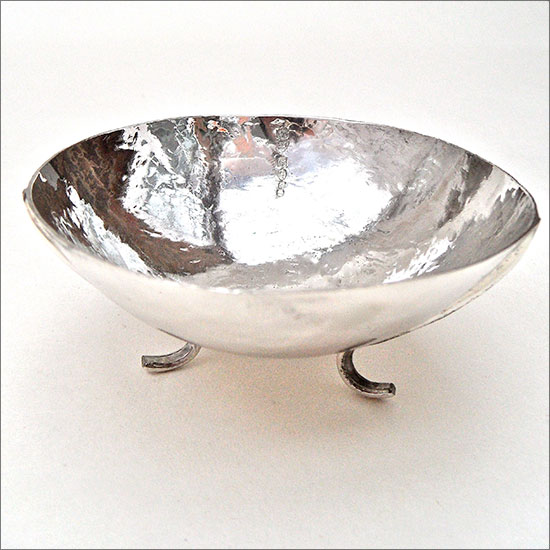Materials: sterling silver
Hand raised and formed. High polish inside and outside. 3 supporting feet.
Photo credit: Gill Bridgestock
Gill Bridgestock
Tenterden, Kent. UK
I was born in Royal Tunbridge Wells and grew up in Sussex. I’ve always been artistic having studied fine art and then became photographers assistant to a fashion photographer in London after-which I was a stylist for Darius Photography and Nestle tinned instant dessert labels. My father was a professional photographer all his life and because home was the base for dads business, mum was the homemaker, secretary, hostess, chief cook and bottle washer and was a dab hand at amazingly extravagant flower arrangements. I had an interesting upbringing as there were always artists and writers at home. I love to create on the fly which produces some interesting work. I also enjoy the detailed work of weaving silver & gold on a loom, it is time consuming as it has to be kept even & flat, it does however produce a stronger denser texture which I then use to create jewellery. You could say that there is a dichotomy between the styles of jewellery I make as I also love using silver sh eet as well as casting silver. Most importantly I have fun. Opening my studio twice a year to the public is a good opportunity to meet new faces and hear what people have to say about my work. There is always something new to explore with silversmithing, it feeds my soul.You’ll see new aspects of it in upcoming pieces as they progress and evolve. What started as a hobby ten years ago has turned into a passion. It has become a totally absorbing experience and a great journey to be on.
These containers and vessels definitely hold their place in the world of stunning art objects as well as in the world of metalsmithing.
Since the dawn of time humans have created containers to hold things that were important to them, from large vessels to hold food and harvests to intimate containers for small precious things. They might hold memories, ashes, medicine, beverage, fruit or food - but all spring from the imagination and skill of the maker. Some have specific religious functions, some are meant for everyday use. When one thinks of a vessel or container the inclination is to think of something with solid walls - yet many of these works involve the exploration of positive and negative space, and the use of negative space to help create the illusion of the wall of the vessel.
As the world’s largest jewelry related internet site, Ganoksin strives to develop exhibitions showcasing work from around the world. This exhibition was open to all metalsmiths, professional and amateur, advanced and beginner. Participants are from The Netherlands, the USA, Canada, Australia, Costa Rica, the United Kingdom, Israel, Hong Kong, Colombia, Romania, Italy, Ireland, Japan, Malaysia and Denmark. While most of the pieces are by an individual metalsmith, some are collaborations, one of three artists spanning 50 years.
In total 319 artists contributed 729 show pieces for the permanent online exhibition.
Objects in the exhibition include boxes, lockets, urns, ash containers, bowls, wine cups, reliquaries, match holders, vases, teapots, pitchers, sugar bowls, baskets, nests, pillboxes, clutches and a range of sculptural forms. A variety of techniques are showcased covering a wide range of metalsmithing techniques. Materials used include everything from gold and silver to less expensive metals. Ornamentation includes the addition of enamel, chasing and repousse’, gemstones and found objects.
The exhibition was curated by Beth Wicker, President of the North Carolina Society of Goldsmiths in the United States, and Adjunct Instructor at Northeastern Technical College in South Carolina. Director of the exhibition is Hanuman Aspler, founder of The Ganoksin Project, the world’s largest internet jewelry site.
